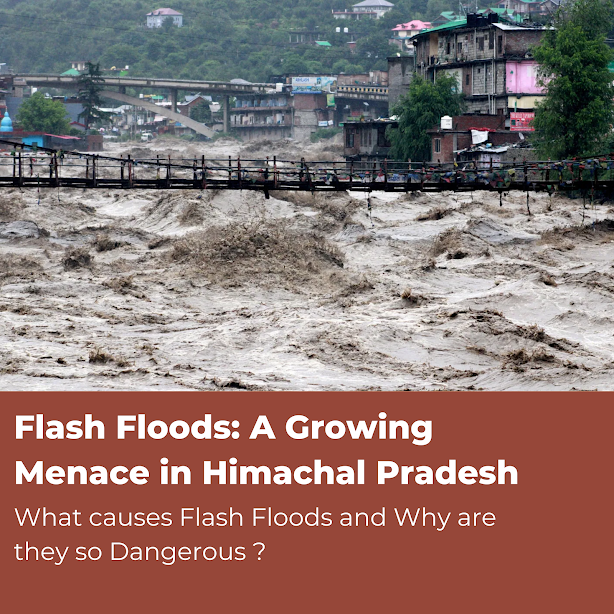Flash Floods: A Growing Menace in Himachal Pradesh
The recent flash flood in Tosh Nullah, Kullu
district, is a stark reminder of the increasing vulnerability of Himachal
Pradesh to these catastrophic events. While floods are a common occurrence in
the state, flash floods, with their sudden onset and destructive force, pose a
unique challenge. The state has suffered losses to the tune of Rs 425 crore in the ongoing monsoon, according to the state emergency operation centre.
What are Flash Floods?
A flash flood is a rapid and violent overflow
of water. Unlike regular floods which develop gradually over hours or days,
flash floods can occur within minutes or hours of heavy rainfall. These are
often triggered by intense thunderstorms, but can also be caused by dam
failures or rapid snowmelt. The speed and force of flash floods make them
extremely dangerous.
Features of Flash Floods
- Sudden onset: Flash
floods develop rapidly, leaving little time for warning or evacuation.
- Rapid water rise: Water
levels can rise incredibly quickly, often engulfing entire areas. - High water velocity: Flash
flood waters carry immense force, capable of sweeping away vehicles,
homes, and people. - Limited visibility: Heavy
rainfall and debris can severely reduce visibility, making navigation
hazardous. - Localized impact: Flash
floods often affect smaller geographic areas compared to regular floods.
Flash Floods vs. Floods
While both are caused by excessive water,
flash floods and regular floods differ significantly:
|
Feature |
Flash Flood |
Flood |
|
Onset |
Rapid |
Gradual |
|
Water level rise |
Rapid |
Gradual |
|
Water |
High |
Lower |
|
Geographic scope |
Localized |
Widespread |
|
Warning |
Short |
Longer |
Frequency of Flash Floods
and Floods
Himachal Pradesh, with its mountainous terrain
and monsoon climate, is prone to both flash floods and regular floods. The
frequency of these events has increased in recent years due to climate change,
deforestation, and unplanned urbanization. While regular floods are more
predictable, flash floods remain a significant threat due to their
unpredictable nature.
Factors
Contributing to Flash Floods in Himachal Pradesh
Himachal Pradesh, once a model of sustainable
development in mountainous regions, now faces a critical juncture. While
liberalization brought economic growth and social progress, it also accelerated
the exploitation of natural resources, leading to environmental degradation.
Hydropower projects, a cornerstone of the state’s economy, have transformed pristine
rivers into artificial channels. The construction of tunnels and the improper
disposal of construction waste have increased the risk of landslides and
floods.
Tourism-driven infrastructure development, including road expansion, has compromised the
mountain’s ecological stability. The shift from traditional road designs to
shorter, steeper cuts has heightened the risk of landslides and erosion.
The establishment of cement plants has altered the region’s
landscape, reducing the land’s ability to absorb water and increasing flood
risks. Additionally, the transition from subsistence farming to cash crops has
led to rapid infrastructure development, often without adequate environmental
considerations, exacerbating the problem.
Himachal Pradesh
stands at a crossroads. Balancing economic growth with environmental protection
is essential to ensure the state’s long-term sustainability and resilience.
Unsustainable
Development Construction in
vulnerable areas can worsen the impact of flash floods by altering natural
drainage patterns.
Climate Change Changing rainfall patterns and increased frequency of
extreme weather events due to climate change contribute to the worsening flash
flood situation.
Orographic Rainfall Himachal Pradesh’s mountainous terrain often leads to
heavy rainfall as moisture-laden air is forced upwards, causing intense
downpours.
Cloudbursts Sudden,
extreme rainfall events known as cloudbursts are common in the region and are a
primary cause of flash floods.
By understanding these factors and
implementing appropriate measures, Himachal Pradesh can significantly reduce
the devastating impact of flash floods.
Why
Flash Floods are so dangerous?
Flash floods are incredibly dangerous due to
their sudden and violent nature.
Hazards
- Rapid Onset: Flash
floods can develop within minutes, leaving little time for evacuation. - High Water Velocity: The
swift current can carry away people, vehicles, and debris with immense
force. - Debris: Floodwaters often carry large objects
like rocks, trees, and cars, which can cause severe damage and injury.
- Limited Visibility: Murky
water reduces visibility, making navigation extremely difficult. - Underestimation of Depth:
People often underestimate the power of floodwaters, leading to drowning.
Impacts
- Loss of Life: Flash
floods are a leading cause of weather-related deaths. - Property Damage: Homes,
businesses, and infrastructure can be severely damaged or destroyed.
- Economic Loss: Disruption
to businesses, agriculture, and transportation can lead to significant
economic losses. - Environmental Damage:
Erosion, pollution, and habitat destruction can occur. - Psychological Impact: Flash
floods can cause significant emotional trauma and stress for survivors.
Ways to Deal with Flash Floods
The Himachal Pradesh government has taken
several steps to mitigate the impact of floods and flash floods, including
early warning systems, disaster response teams, and infrastructure development.
However, more needs to be done.
Prevention and Mitigation
- Early Warning Systems:
Advanced weather forecasting and early warning systems are crucial. These
can provide precious minutes or even hours for people to evacuate. - Land Use Planning:
Careful land use planning, including identifying and avoiding high-risk
areas for construction, can significantly reduce vulnerability. - Reforestation and Afforestation:
Healthy forests act as natural sponges, absorbing rainwater and reducing
runoff. - Infrastructure Development: Building
resilient infrastructure like retaining walls, check dams, and proper
drainage systems can help channel water and prevent flooding. - Community Awareness:
Educating people about the risks of flash floods, evacuation procedures,
and emergency preparedness is vital. - Disaster Preparedness Drills:
Regular practice can help communities respond effectively to flash flood
emergencies.
Response and Recovery
- Emergency Response Teams:
Well-trained and equipped emergency response teams are essential for
rescue and relief efforts. - Search and Rescue Operations:
Effective search and rescue operations are crucial in the immediate
aftermath of a flash flood. - Medical Assistance:
Ensuring timely medical care for injured victims is paramount. - Shelter and Relief:
Providing temporary shelter, food, and essential supplies to affected
populations is vital. - Infrastructure Repair:
Quickly repairing damaged infrastructure is essential for restoring
normalcy. - Psychological Support:
Offering psychological support to those affected by the trauma of a flash
flood is crucial for long-term recovery.
The recent flash floods in Kullu district
underscore the urgent need for comprehensive flood management strategies. By
understanding the characteristics of flash floods and taking proactive
measures, Himachal Pradesh can significantly reduce the loss of life and
property caused by these devastating events.
Post a Comment
You must be logged in to post a comment.


